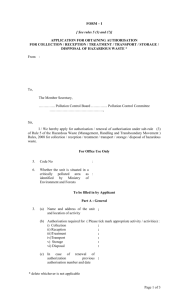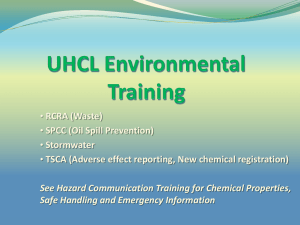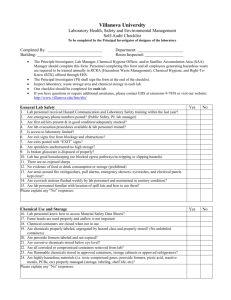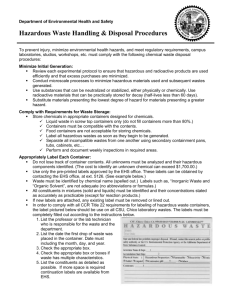Chemical Use & Waste Management
advertisement
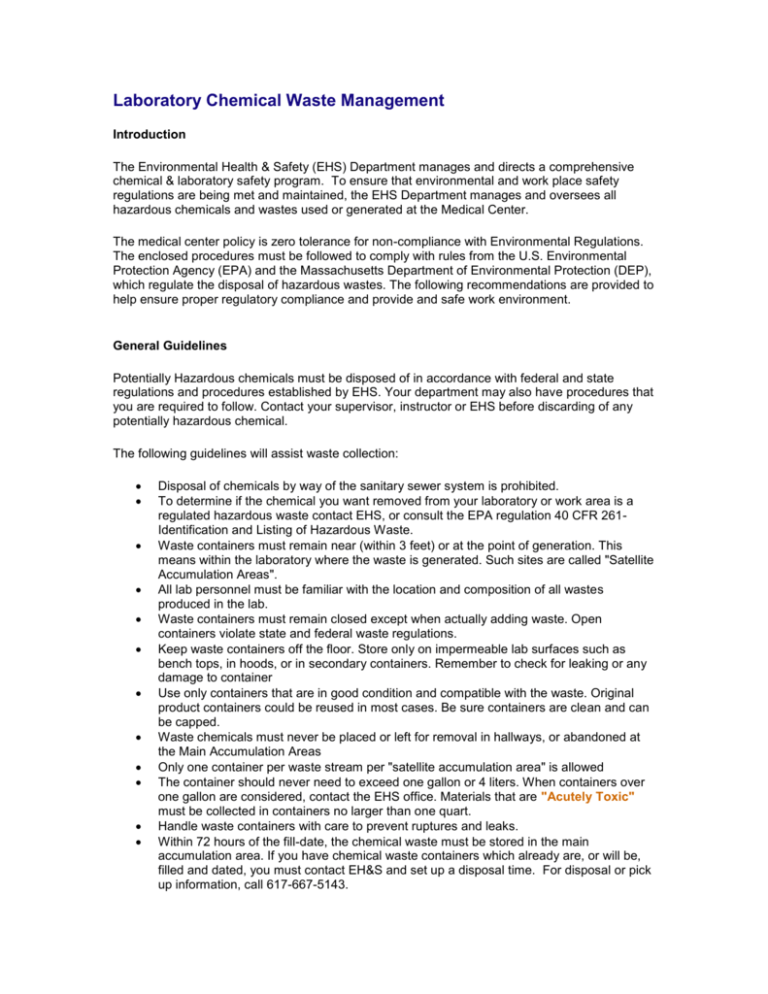
Laboratory Chemical Waste Management Introduction The Environmental Health & Safety (EHS) Department manages and directs a comprehensive chemical & laboratory safety program. To ensure that environmental and work place safety regulations are being met and maintained, the EHS Department manages and oversees all hazardous chemicals and wastes used or generated at the Medical Center. The medical center policy is zero tolerance for non-compliance with Environmental Regulations. The enclosed procedures must be followed to comply with rules from the U.S. Environmental Protection Agency (EPA) and the Massachusetts Department of Environmental Protection (DEP), which regulate the disposal of hazardous wastes. The following recommendations are provided to help ensure proper regulatory compliance and provide and safe work environment. General Guidelines Potentially Hazardous chemicals must be disposed of in accordance with federal and state regulations and procedures established by EHS. Your department may also have procedures that you are required to follow. Contact your supervisor, instructor or EHS before discarding of any potentially hazardous chemical. The following guidelines will assist waste collection: Disposal of chemicals by way of the sanitary sewer system is prohibited. To determine if the chemical you want removed from your laboratory or work area is a regulated hazardous waste contact EHS, or consult the EPA regulation 40 CFR 261Identification and Listing of Hazardous Waste. Waste containers must remain near (within 3 feet) or at the point of generation. This means within the laboratory where the waste is generated. Such sites are called "Satellite Accumulation Areas". All lab personnel must be familiar with the location and composition of all wastes produced in the lab. Waste containers must remain closed except when actually adding waste. Open containers violate state and federal waste regulations. Keep waste containers off the floor. Store only on impermeable lab surfaces such as bench tops, in hoods, or in secondary containers. Remember to check for leaking or any damage to container Use only containers that are in good condition and compatible with the waste. Original product containers could be reused in most cases. Be sure containers are clean and can be capped. Waste chemicals must never be placed or left for removal in hallways, or abandoned at the Main Accumulation Areas Only one container per waste stream per "satellite accumulation area" is allowed The container should never need to exceed one gallon or 4 liters. When containers over one gallon are considered, contact the EHS office. Materials that are "Acutely Toxic" must be collected in containers no larger than one quart. Handle waste containers with care to prevent ruptures and leaks. Within 72 hours of the fill-date, the chemical waste must be stored in the main accumulation area. If you have chemical waste containers which already are, or will be, filled and dated, you must contact EH&S and set up a disposal time. For disposal or pick up information, call 617-667-5143. For disposal of mixed wastes (radioactive & chemical) materials call Radiation Safety at 617-667-2510. Satellite Accumulation Areas These are locations within laboratories where chemical wastes are collected and properly stored until they are picked up by EHS. Each area must be posted designating it as the Satellite Accumulation Area. See sign below. SATELLITE ACCUMULATION AREA Please Post Do you know your responsibilities for proper handling of hazardous waste? Please review the following requirements to ensure that you comply with environmental regulations and safe handling procedures. Chemical Waste Disposal Service The Environmental Health & Safety Department has a chemical waste disposal service in place that is designed to keep the Medical Center and Research Laboratories in regulatory compliance with proper disposal requirements. The Chemical Waste Collection program requires the laboratory generating chemical waste to contact the hazardous waste pickup line at 7-5143 or pager 94186 for BIDMC or 30861 for CLS to schedule a collection or drop off time. All chemical waste must be brought to a collection area within 3 days of filling a chemical waste container. The following are designated as Main Accumulation areas for chemical waste collections (waste will be collected at the location which it is generated). Slosberg-Landay Basement, SL-B03 Research North 1st floor, RN-185 Clinical Center West, 2nd floor CLS Loading Dock Hazardous Waste Defined Hazardous materials have hazardous characteristics such as: flammable, corrosive, reactive, toxic, radioactive, poisonous, carcinogenic or infectious. In a general sense, these materials are considered hazardous because they present a potential risk to humans and/or the environment. By law a hazardous waste is defined as a waste, or combination of wastes, that because of its quantity, concentration, or physical, chemical or infectious characteristics may cause or significantly contribute to an increase in serious irreversible, or incapacitating reversible illness or pose a substantial present or potential hazard to human health, safety or welfare or to the environment when improperly treated, stored, transported, used or disposed of or otherwise managed. Hazardous waste management plans generally separate waste into three broad groups: radioactive, chemical and biological. This guide addresses only chemical waste. Hazardous waste includes a wide range of material such as discarded commercial chemical products, process wastes and wastewater. Some chemicals and chemical mixtures are hazardous wastes because they are specifically listed by the EPA. Most of the common laboratory solvents are listed wastes. A chemical waste that is not listed by the EPA is still a hazardous waste if it has one or more of EPA's four hazardous characteristics: ignitablity, corrosivity, reactivity or toxicity. Classification of Chemical Waste A chemical waste is considered to be a hazardous waste if it is specifically listed by the EPA or DEP as a hazardous waste or if it meets any of the four hazardous characteristics below. If a chemical waste is not on the EPA list of hazardous wastes, and does not meet any of the hazardous waste characteristics, it is a nonhazardous waste. For complete definitions of hazardous characteristics of waste see the EPA regulation 40 CFR 261-Identification and Listing of Hazardous Waste. Ignitable/Flammable A liquid which has a flash point of less than 60°C is an ignitable waste (e. g. Acetone, Methanol). A solid is an ignitable waste if it is capable of causing fire through friction or absorption of moisture, or can undergo spontaneous chemical change which can result in vigorous and persistent burning under standard temperature and pressure (e. g. Benzoyl Peroxide). A substance which is an ignitable compressed gas or oxidizer is an ignitable waste (e. g. Propane, Hydrogen Peroxide). Corrosive(Acid/Base) An aqueous solution which has a pH less than or equal to 2 or greater than or equal to 12.5 (e. g. Hydrochloric Acid, Sodium Hydroxide),or is a liquid and corrodes steel at a rate greater than 6.35 mm per year at a test temperature of 55°C, is a corrosive waste. Reactive A reactive waste is a material that is normally unstable and undergoes violent chemical change without detonating, can react violently with water to form potentially explosive mixtures or can generate dangerous or possibly toxic gases, vapors or fumes in a quantity sufficient to present a danger to public safety, health or welfare or to the environment; or a material that is capable of detonation or explosive decomposition or reaction at standard temperature (e. g. Picric Acid, Potassium Cyanide, Lithium Aluminum Hydride). Toxic A waste that contains one of the constituents in concentrations equal to or greater than the values listed in EPA regulation 40 CFR 261-Identification and Listing of Hazardous Waste is a toxic waste. Disposal of Unknowns All chemicals must be identified and containers properly labeled at all times. Each laboratory is responsible for seeing that this requirement is met. If an unknown chemical is discovered, label it as "unknown" and attach a note detailing any information about what the chemical may be or what experiment it may have been used for and where it was found. Contact EHS for disposal information. If you find any unlabeled chemical that has crystallized or there is any other indication that it may be unstable, DO NOT TOUCH IT! Contact EHS (617) 667-3088 immediately. Requirements for Hazardous Waste Management in the Laboratory Laboratories and other areas that generate hazardous waste are required to comply with the generator requirements of the Resource Conservation and Recovery Act (RCRA, CFR Title 40) and Massachusetts Hazardous Waste Management Regulations (310 CMR 30.0). Every generator site (laboratory) is subject to inspection by the EPA and DEP. The steps necessary for compliance are summarized below. Weekly Inspections - items to be inspected are listed on the Satellite Accumulation Area checklist. The Principal Investigator/Lab Safety Coordinator is responsible for assuring this inspection is done weekly. Segregation and Containment - the wastes must be separated by chemical compatibility groups. Each group of containers must be provided with appropriate secondary containment. Containment trays and tubs are available from EHS. Additional information on compatibility is provided below. Storage - only one container per waste stream (type of waste) is allowed in a lab, i.e., one container for halogenated solvents, one container for non-halogenated solvents. Closed Containers - all containers must be closed at all times except when actually adding waste. Labeling Each container must be labeled with a BIDMC Chemical Disposal Label. When the container is full place the date when full on the label. Plan ahead and contact Environmental Health & Safety at 7-5143 or pager 94186 for BIDMC or 30861 for CLS to arrange for a waste pick-up. You must provide your own collection container. Collect hazardous chemical waste in a labeled, screw top container (glass or plastic – depending on waste to be collected) Fill out the Hazardous Waste Disposal Label when waste generation has begun; complete the label once the container is full. Fill out all areas when generation has begun except the Fill Date. This is required when the bottle is full and ready for pickup. Use chemical names on the label. Do not use formulas or abbreviations. Constituents of chemical by volume percentages is required. Hazardous Waste for Disposal Complete label and affix onto container prior to collecting waste Room # _________________________ Fill Date ______________ Department ___________________________ Ext _____________ Contents 1._______________________________ % ________ 2)_______________________________ % ________ 3._______________________________ % ________ 4.________________________________% ________ Check the HAZARD: ____ Ignitable ____ Corrosive ___ Reactive ____ Toxic Chemical Compatibility The following chart is provided as a guide to segregating hazardous waste containers; it is not to be used for mixing chemicals. Containers of incompatible wastes must be stored in separate areas. Secondary containment bins are available for purchase; contact EHS at 7-3088 for recommended products. Many hazardous wastes, when mixed with other waste or material, can produce effects which are harmful to human health and the environment, such as (1) heat or pressure, (2) fire or explosion, (3) violent reaction, (4) toxic dusts; mists, fumes, or gases, or (5) flammable fumes or gases. Below are examples of potentially incompatible wastes, waste components, and materials, along with the harmful consequences that might result from mixing material in one group with material in another group. The list is intended only as a guide to indicate the need for special precautions when managing these potentially incompatible waste materials or components. This list is not all-inclusive. In the lists below, the mixing of a Group A material with a Group B material might have the potential consequences as noted. Chemical Compatibility Chart Group 1-A Group 1-B Alkaline Liquids Acid Liquids Potential consequences: Heat generation, violent reaction Group 2-A Group 2-B Aluminum Wastes in Group 1-A or 1-B Beryllium Water Calcium Air Magnesium Alcohols Sodium Other reactive metals and metal hydrides Potential consequences: Fire or explosion generation of flammable hydrogen gas Group 3-A Alcohols Water Group 3-B Concentrated waste in Groups 1-A or 1-B Calcium Lithium Metal hydrides Potassium Other water-reactive wastes Potential consequences: Fire, explosion, or heat generation; generation of flammable or toxic gases. Group 4-A Group 4-B Alcohols Concentrated Group 1-A or 1-B wastes Aldehydes Group 2-A wastes Halogenated hydrocarbons Nitrated hydrocarbons Unsaturated hydrocarbons Other reactive organic compounds and solvents Potential consequences: Fire, explosion, or violent reaction. Group 5-A Spent cyanide and sulfide solutions Group 5-B Group 1-B wastes Potential consequences: Generation of toxic hydrogen cyanide or hydrogen sulfide gas Group 6-A Group 6-B Chlorates Acetic acid and other organic acids Chlorine Concentrated mineral acids Chlorites Group 2-A wastes Chromic acid Group 4-A wastes Hypochlorites Other flammable and combustible wastes Nitrates Ammonia Nitric acid, fuming Perchlorates Permanganates Peroxides Potential consequences: Fire, explosion, or violent reaction. Empty Containers Generally empty chemical containers are not considered hazardous waste. The container must be completely empty, that is all of the contents that can be removed by normal means must be removed and the residue must be less than 1%. The word "empty" must be written across the label. The container may then be disposed of in the regular trash. An exception to the above applies to containers that held chemicals listed by the EPA and MADEP as "Acutely Hazardous Wastes". The most common laboratory chemicals found on this list are: Acrolein Allyl alcohol Compounds containing Arsenic Carbon Disulfide Compounds containing Cyanide 2,4, Dinitrophenol Nitric oxide Nitrogen dioxide p-Nitroaniline Osmium Tetroxide Phosgene Phosphine Sodium Azide Vanadium pentoxide A complete list of the Acutely Hazardous Wastes can be found the EPA regulation 40 CFR 261-Identification and Listing of Hazardous Waste. Empty containers that formerly held any of these Acutely Hazardous Wastes in the pure unused form, not mixtures or spent material, must be disposed of as hazardous waste. Mutagen Carcinogen Policy Mutagens and carcinogens are used extensively in laboratories. A list of the most commonly used chemicals in this category is provided in the following table. (Remember this is not a comprehensive list). Mutagen or carcinogen waste in solid form or concentrated solution is hazardous chemical waste and must not be thrown in the trash or down the drain. Call the EHS office (7-5143) to arrange for pick-up of your hazardous waste or if you need more information. Chemical CAS Number Chemical CAS Number 1,2-Dibromo-3-chloropropane 96-12-8 2-Aminofluorene 153-78-6 Benz[a]anthracene 56-55-3 1,1-Dimethylethylenimine Ethylenedibromide 106-93-4 Benzo[a]pyrene 50-32-8 Propylenimine 75-55-8 Chlorambucil 305-03-3 Ethionine 67-21-0 Cycasin 14901-08-7 Diazomethane 334-88-3 Dibenz[a,h]anthracene 53-70-3 7,12-Dimethylbenz[a]anthracene 57-97-6 3'-methyl-4-amino-azobenzene Urethane 51-79-6 Bromoethylmethanesulfonate Chloromethylmethylether 107-30-2 4-Dimethylaminazobenzene 60-11-7 Diepoxybutane 1464-53-5 3-3'-Dimethylbenzidine 612-82-8 Dimethyleaminobezene 60-11-7 1,4-Dinitrosopiperazine 140-79-4 1,1-Dimethylhydrazine 57-14-7 N-Hydroxy-2-acetylaminofluorene 1,2-Dimethylhydrazine 540-73-8 3-Methylcholanthrene 56-49-5 Ethidium Bromide 1239-45-8 4,4'-Methylenebis(2-chloroaniline) 101-14-4 Ethylmethanesulfonate 62-50-0 Methyazomethyl acetate 5926-62-1 Hydrazine 302-01-2 1-Methyl-3-nitro-1nitrosoguanidine Methylhydrazine 60-34-4 1-Naphthylamine Methylmethanesulfonate 66-27-3 N-[4-(5-Nitro-2-furyl)-2-thiazoyl]formamide N-Nitorsodiethylamine 55-18-5 N-Nitroso-N-ethylurea N-Nitrosodimethylamine 62-75-9 N-Nitroso-N-methylurea 684-93-5 N-Nitrosodi-n-butylamine 924-16-3 4-Nitroquinoline-1-oxide 56-57-5 N-Nitrosodi-n-propylamine 621-64-7 Procarbazine 366-70-1 1,3-Propanesultone 1120-71-4 N-Nitroso-N-ethylurethane 70-25-7 N-Nitroso-N-methylurethane 615-53-2 m-Toluenediamine 95-80-7 N-Nitrosopiperidine 100-75-4 Uracil mustard 66-75-1 Polychlorinatedbiphenyls 11141-16-5 4-Aminobiphenyl 92-67-1 ß-Propiolactone 57-57-8 Benzidine 92-87-5 3,3'-Dichlorobenzidine 91-94-1 N-Acetoxy-2-acetylaminofluorene 2-Acetylaminofluorene 53-96-3 3,3'-Dimethoxy-benzidine 20325-40-0 Aflatoxins- 1162-65-8 2-Naphthylamine 91-59-8 97-56-3 4-Nitro-biphenyl Methylnitrosourea 17ß-estradiol ø-Aminoazotoluene Chemical Waste Minimization The specialized handling and disposal required for hazardous chemical wastes, as well as the hazards, result in operational, economic, and safety reasons for minimizing the generation of such wastes. Listed below are several waste minimization techniques that may be put to practical use throughout the hospital. This is not a comprehensive list of all possible waste minimization methods, but those most likely to be found feasible to employ within the hospital environment. For more information, please contact the EHS Department. All chemical users are required to consider hazardous chemical waste minimization during the planning of all chemical procedures. Waste minimization activity will be a periodic focus of safety audits in labs so that we can identify what works and build on our success throughout the rest of the organization. Planning purchases A substantial portion of the hazardous waste produced at this hospital consists of unused, outdated chemicals sometimes in unopened original containers. Prior to purchase careful consideration must be given to: the amount of chemical required over a given period of time the shelf life of the chemical the costs of disposal. Purchasing in bulk, in an attempt to reduce the purchase price of individual items, frequently results in needless disposal costs that far outweigh the savings in the original purchase. Inventory practices Set up good inventory practices to check for and use products before expiration dates occur. Properly rotate all stock. Order only when necessary to prevent overstocking. Avoid the use of standing orders. Substitution Replace or substitute a toxic or hazardous chemical product with a non-toxic or less toxic substance. Check with suppliers and manufacturers for possible alternatives to the hazardous products being used. Many less hazardous substitutes are currently being developed. Microscale procedures Occasionally, work can be adapted to reduce the scale of experiments or procedures, thereby achieving acceptable results while using smaller quantities of chemicals and resulting in a decreased amount of waste. The use of smaller quantities of chemicals can also reduce occupational exposures to chemical hazards. Recovery Commercial waste processing companies recover many chemicals for reuse in the manufacture of commercial products. Silver and mercury may be recovered on site through commercially available filtration methods. The recovered material can then be reused or sold. Silver recovery is currently practiced in the Photography and Radiology departments and numerous labs. Recovery activity must be coordinated through the Safety Office to assure that proper permits are obtained and that the recovery complies with all other pertinent regulations. Recycle/reuse Some chemicals can be reused several times in a procedure before needing to be disposed of as waste. Certain chemicals can be re-purified by distillation prior to reuse. Check with chemical manufacturers and distributors for technical information concerning chemical reuse. The Pathology department currently recycles quantities of xylene, xylene-substitutes and formalin using distillation methods. All recycling/reuse must be coordinated through the Safety Office to assure that proper permits are obtained and that the activity complies with all other pertinent regulations. MWRA Compliance Page & List of Chemicals Restricted from Sink Disposal



